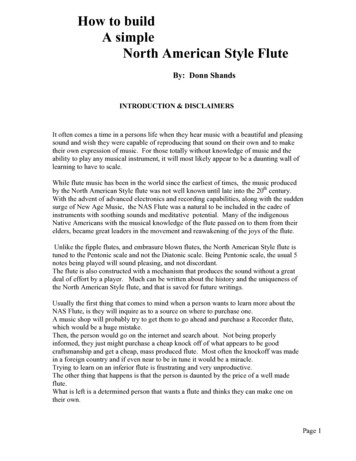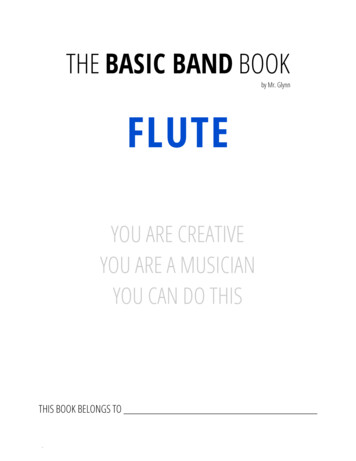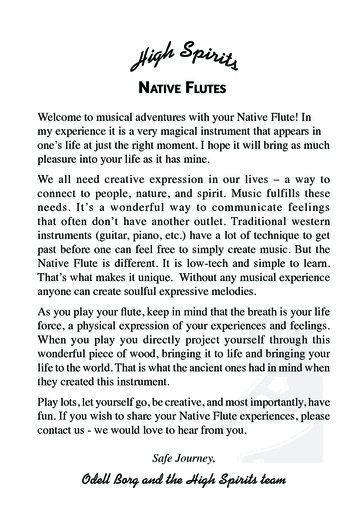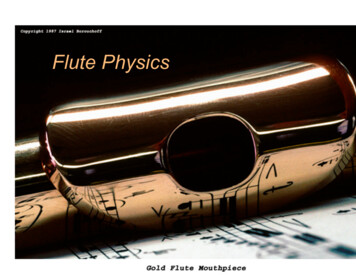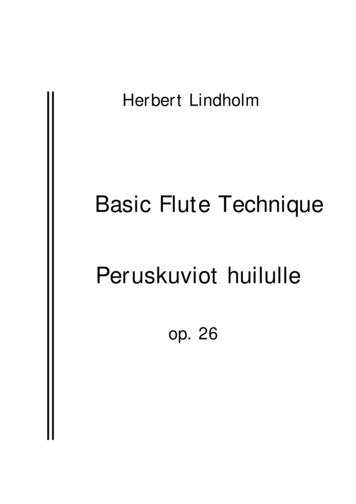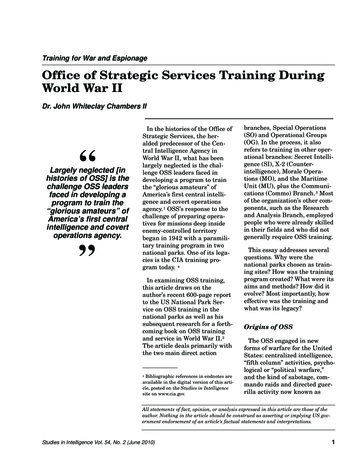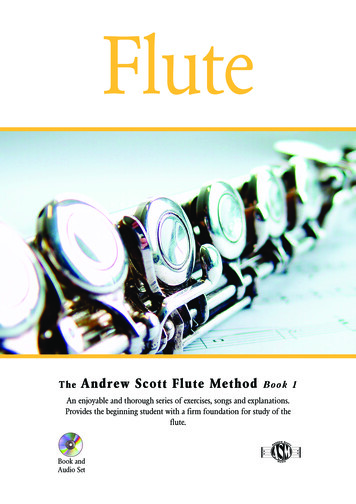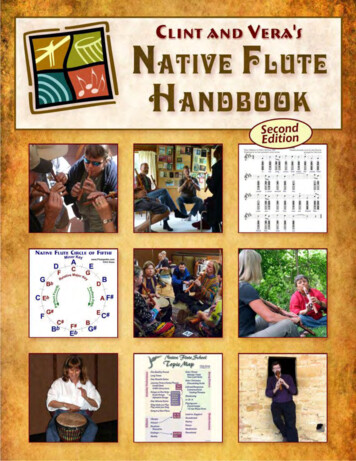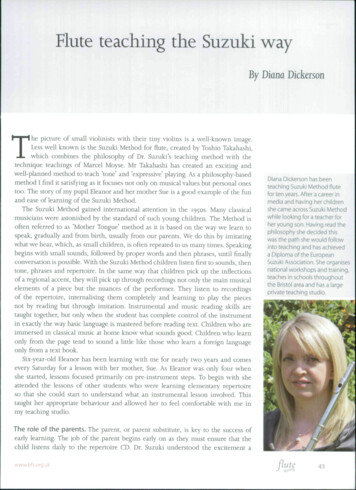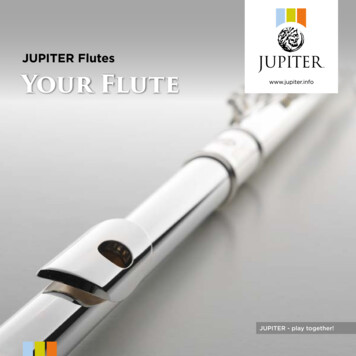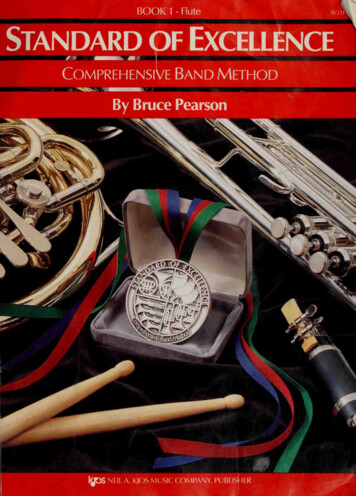
Transcription
PREHENSIV;
Practice JournalWeek
BOOK1-FluhStandard of ExcellenceComprehensive Band MethodBy Bruce Pearson Y ea aaOo 3Dear Student:Welcomeyouto the wonderful world of instrumental music. The moment you pick up your flute,begin an exciting adventure that is filled with challenges and rewards. If you studywillcarefullybeautifulIand practice regularly, you will quickly discover the joy and satisfaction of playingmusic for yourself, your family, your friends, or a concert audience.hope you have many rewarding years of music-making.Best wishes,PracticingMake-the key toEXCELLENCE!practicing part of your daily schedule.plenty of time forIfyou planitasyou do any otheractivity,youwill findit.same place every day. Choose a place where you can concentrate on makingwarm-up routine, including long tones and simple technicalan athlete, you need to warm-up your mind and muscles before you begin performing.every practice session. Keep track of your practice time and progress on the front coverTry to practiceinthemusic. Start with a regular and familiarexercises.LikeSet goals forPractice Journal.Practice the hard spotsinyour lesson assignment and band music over and over,them perfectly.Spend time practicing both alone and with theSTANDARD OF EXCELLENCEuntilyou can playrecorded accompani-ments.At the end of each practice session, play something fun.ISBN 0-8497-5926-9 1993 Neil A. Kjos Music Company, 4380Jutland Drive, San Diego, California.International copyright secured. All rights reserved.Printedinthe U.S.A.WARNING! Governmentsaround the world provide copyright laws to encourage composition and publicationot new music. Anyone copying this music without permission is breaking the copyright law and is subject to penalties.inv w.iv Thank you!Please do not violate copyright laws. Do not ropy or reproduce the contents of this bonl.I PS NEIL A. KIOS MUSIC COMPANY, PUBLISHER
PuttingYour Flute TogetherHEAD JOINTMIDDLE JOINTembouchure holeembouchureFOOT JOINTtone holes— ' /' UiUiplateE flat keySTEP1Open yourcaseright side up.STEP 2Put the head joint into the middle joint with a gentletwisting motion.STEP 3Lineup the embouchure hole with the center of thetone holes.STEP 4Hold the assembled head and middletwist on the foot joint.W21FLSTEPSjointsand gentlyLineup the foot joint so the rodtone holes.iscentered with the
PreparingToPlaySTEP1Situpstraighton the edge of yourchair.STEP 2Makea "C" with yourlefthand sothatyou form ashelf atthe base of your thumb. Rest the flute on that shelf.STEP 3Place yourleftunderside of therestthumb onflute.the long straight key on theMove your left hand to the right andthe flute at the base of the index fingerknuckle andbetween thefirst joint.STEP 4Place thefirsttipof your rightand secondt-thumb under the flute between theII fingers.STEPSCurving your fingers on both hands, place your right littlefinger on the El key. Your elbows should be away fromyour body. The flute should be pointing slightly downward.PlayingYourSTEP1Remove the head joint andFluteplace your right hand over theas if saying "whee-too."open end. Shape your mouthSTEP 2Place the head joint on your chin,andpositionitso that theedge of the embouchure hole is at the bottom of the lowerlip.The corners of the lower lip should rest against theembouchure plate.STEP 3ZyCover 1/4 to 1/3 of the embouchure hole with your lowerlip. Take a full breath of air and blow over the hole usingthe syllable "doo" to play a long, steady tone.STEP 4Assemble the head joint to the body. Position your flutetothe right of your body, with the flute pointing slightlydownward.-STEPSTake afullbreath ofairand play along, steady tone.Caring For YourFluteSTEP!After playing, dry the inside of your flute with a soft clothover a cleaning rod.STEP 2Shake the water out ofthe head joint. Wipe the joints clean.STEP 3Wipe theoutside of your flute with aCarefully put awayallsoft,clean cloth.parts of your flute and latch your case.W21FL
For Flutes OnlyTREBLECLEFTIMEWHOLESIGNATURENOTE WHOLEoREST'' rS M.Ledger Linex4 4 counts4inS keachfff) measureBar LinesX—J Staff,Measures'A wholenote getsA wholerest gets4 countsin time.4 countsin -o-A flatFLAT-o\ ?- oneB[ B---f time.(1?)lowers the pitch of a notehalf step.for the entireIt remainsmeasure.ineffectBbTHE MAGIC FLUTEBflat(Bb)BbP t -o--o-o open pressed down oo »oo A double-o-bar line marks the end of the music.THE "A" TRAINAAMA3XXE3X3XXH o o o o TWO TONEMFLUTERS : Use plenty ofGMA-o-XEair.Q G WHIZA- XEG-o--o--o--o- o o o FLUTE PURSUIT XE-O-XEAre you playing with a good embouchure and hand position?9 rumiFLUTiEXE-O--o-XEFLUTE COCKTAIL iHowW21FL-oisyour posture?XE-o--o-
For Woodwinds OnlyTREBLECLEFTIMEWHOLESIGNATURENOTELedger Lino \ iP4 countsin eachmeasureFLAT/Bar LinesXStafl\Measuresm \ oWHOLERESTA wholenote getsA wholerest gets4 countsin time.4 countsin time.- A9- -flatoneBb(l )lowers the pitch of a notehalf step.Itremainsin effectmeasure.for the entireBbTHE FIRST NOTED.LD.m-»-o open pressed down -O--O-- *-- *-Adouble barlinemarks the end of the music.THE SECOND NOTEc.cXEXEXE/ooiooo TEA FORPTWOUse plenty- XE-o-ofXEair.THE THIRD NOTE Bflat(Bb) oc' .;B[, -o--o--o-c THREE OF A KINDIiXE-o--O-XEAre you playing with a good embouchure and hand position?maTHREE'SCOMPANYt - XEWOODWIND WHIRLWINDPHow -o-isXE-O- your posture?W21FL
ForThe Full BandTREBLECLEFTIMEWHOLESIGNATURENOTERESTj jg j gj m.'liiiiiiifiarrgi'Tff-'Ledger Line 4 countsin eachmeasure\ Bar LinesA wholenote getsA wholerest gets4 countsinI time.4 countsinStaffiMeasures'one(l )lowers the pitch of a noteIt remains in effecthalf step.for the entireD.*6measure.BAND PDf time.-O-A flatTIME FORWHOLEo-o--o--o--o-o open pressed downAdouble barlinemarks the end of the music.THE FUN CONTINUEScc XEXE3X o o o o o WHOLE LOTTA COUNTINGmWrite- in3Xthe countingand clap the rhythm before youFOURSCORE " O O ! O Qjmplay.Bl t when youo XEPage 39 1111 Bflat(Bl )t -O-- --O--o-see a page number followed by an arrow, Excellerate to the page indicated for additional studies.MIX 'EM UPmPa-o-XE-O-XEMELTING POTXE-O-- XEBAND ON PARADEXEILines with aW21FLmedal are AchievementLines.-O-The chart on page 47 can be used to record your progress.
HALF NOTEHALF RESToEach half note gets2 counts in \ time.aEach half2 countsL1,BREATH MARKrest getsin\ time.Take a breath.A BREATH OF FRESH AIRMu-»--o-Be sureto take a51 SIDEfullbreath ofXETf"-O--O-air.BY SIDE- XtXExt-O-- »-[0 TWO BY TWOii- -o-xnHALF THE PRICEPWrite 'in-O-XEalso played (S 15 S -»-Bb P- the counting and clap the rhythm before you play.Page 39CARDIFF BY THE SEAg [0 TWO FOR THE SHOW sXEp-Welsh?Song-O-Duet-o--o-p Folk5pp p-o-pa GO FOR EXCELLENCE!i\ ?r p-o-XE-O-W21FI
8PHRASEEach quarter rest gets1 count in \ time.Each quarter note gets1 count in \ time. i(t)rrrr i A phraseisa musical thoughtor sentence. Phrases are usuallyfour or eight measures long.A QUARTER'S WORTH4urrr "iMrrrrmniWriteini rrrr""ithe counting and clap the rhythm before you play. a HOT CROSS BUNSt clapu —H— — : :K : English FolkUl f-HUlf-H t VrrrinDOWNQO4 marka breath rn ffrr "i r iBY THE STATION :-o-Traditionalr rYrnY rr r :French Folk Songend of each phrase.at theSong-o-PAU CLAIRE DE LA LUNEDraw- rrrrir lyrr rrr r r fMTff y iig EASY STREETE flat (El,)El,.k sxr \}rjja(ghrT\zz:r rIf r r rl0«4 D COUNTRY WALKij '7 f pGETTIN'English FolkHb IT Ir r Z K TOGETHER1 (&F-o- «oo m2Z fff k-o-#ir 'TMf r l pf Songt rr FOR FLUTES ONLYIW21FLI'pi'r m P n(Pf r-*' -o-
REPEAT SIGNCOMMON TIMEFERMATAUHold the note orRepeat from the beginning.Commonthesametimemeansas \ time.restitslonger thanusual value.SOLO
10IETIEA tie 5TIME SIGNATUREm 2 counts in each measure quarter note gets one counta curved line that connects two notespitch. Tied notes are played as onesameof theisunbroken note. a WARM-UPGo looo QrUfJPrf1fpU 11Iy-'PifP'lrP l'"II
11Key signatures changeKEY SIGNATUREcertain notes throughouta piece of music. This key signaturealliB's asBflatsandallE'sas Emeansplayflats.IMARK TIMEMFor lower notes,r\\ff?make yourlipjj i pppjj i i pp Ji p piii pp r\openinglargerand-o-i f r Fdirect your air stream lower.SWEETLY SINGS THE DONKEY - Round r rr1.a MARY,2.,ilS (S -rr- \tr ir-} mthe notenames before youm n CRUSADER'Sin r-ir I rJSongIndies FolkTuttim zzTuttizz:m mt9(5 t UT play.MARCHm p Page 39Traditionalm ms?sthe counting and clap the rhythm before you play.Em BALANCE THEDraw one noteJ raditionalGOoroneSCALESrest tobalance each scale.Jo \\JFOR EXCELLENCE!irir'i"rW21FL
12andbottom notes. section plays the top notesDIVISIpart of the section plays theUNISONdiv.unis.rq»Everyone plays the same notes.BALANCE BUILDER2r\ 43TonicDominantSubdominantTonic/O57 ?rsi-o--O-JINGLE BELLSS.J.Band Arrangementarr. mzzm.t% %tt g f1011 I\ "ii gf1961)II19ffff1rdiv.12 15181 u' (b. unis. 14'fwm13!7'Ifdiv.VElledge4unis.div.mPierpont (1822 -1893)Chuck16«
13 uEIGHTH NOTES rTworeighth notes are as longas a quarter note. uj }rppEach eighth note gets1/2countinn jLiu*pfand\ time.1/2 V2 1countWARM-UPI r\i221-o-r\ XE- ? JH EIGHTH NOTE ENCOUNTERi7\\WriteinJJiJ\the counting for the top line beforeALONGJIMi'''iyouJJJJ[JJJJplay.American Folk SongJOSIEjrfI"JJ\Ifp p LIrIB EIGHTH NOTE EXPLORERiclapiWriteJinJinJTrSHJJJ:l.1JIJJJJJJthe counting for the top line before you play.GO TELLPJGO[JrrrGioacchino Rossini (1792BILLl;r t* i t[j T' mrmfrr-1868) uFOR EXCELLENCE!4 -prr [f rrrnJr r'rrrHrrrcr rrfHrrii[rrW21FL
14D EIGHTH NOTE EXPRESS####f# ###JJff\WriteI.1JJ:lJJJ l; XK K-the counting for the top line before you play.inSKIPLOUIT,TuttiSolo/Soli irAmerican Folk SongTuttiSolo/Solii[jrrI[ r f I rfrEIGHTH NOTE EXPERT#4i'' r m jgrclap- Writein X X r-Kthe counting for the top line before you play.MEXICAN MOUNTAIN SONGMexican Folk SongI P a BAFFLING BARmWritein LINESM the counting anddrawinFOR FLUTES ONLYlb'4 -r—P r?the bar lines before you play.—'" —-— — f p —
15&SLURAcurvedline thatAconnects two or more*PNOTEPICK-UPnote that comes before the#r -Ffirst fullmeasure of a piece of music.notes of different pitches.WARM-UP irTongue only thefirstnote of eachr rI ERIErrIrIrf -*-slur.THEME FROM "SYMPHONY NO.n trIr\1"Johannes Brahms (1833 sii mCANAL CAPERS ffm\}-1897)P\\iAmerican Work SongPage40m4 i rcjr rr r'LT [-rrirLAUGHING SONG Round" Traditional-1.,rrT 2. [JLJSTAR SEARCHrSTtl*iWolfgang Amadeus Mozart&siinthe missing notes for "Twinkle, Twinkle,GO756-179sLittleStar" beforeyouplay.FOR EXCELLENCE!izrr1 0-Draw([jrrrrirrLOJ'iiLrrrrrsFf - W21FI
16 KEY SIGNATUREThis key signatureandallA's asmeansplayallB's asBflats, all E'sas Eflats,A flats.aa CLIMBING STAIRSA flat(A ft o o o yAbm b)i gZZJprrfeiTrirr1&- BINGOPAmerican Folk Songi:s r w i# # mSi THERE'S MUSIC* S *INm0-MT r,r,r'\ George i'F. Root (1820 0-«1895)- THERE'S THE SAME MUSIC IN THE AIR F\THE AIRjirrriGeorgeF.Root (1820-1895)m.PCircle the notesra SCALEchanged by the keysignature.SKILLf"""rrrr rfi'iM"iIr rirr rrrriirfFOR FLUTES ONLYQc;rW21FLtQj:ji;r
17DOTTEDHALF NOTEAdot afterTIME SIGNATURE
18ANATURALItnatural sign cancels aremainsinflator a sharp.effect for the entire measure.WARM-UP :A flatAb(A b)5 IE llooo OLD BLUESolo/Solilo/Soli1LTr'' rIs J s rrIit l;ri i/Solo/Soli 4s—H u\r' rg THIRD TIMEI\irAROUND mCircle the notesi, .JrIcj' itIi " signature.mM0-U*irTraditional.- A.' s't ;iJLULLABY -Duet,s—TuttiM [J9A Jchanged by the keyTTraditionali pB. s? SP My y?i»MINUTEMAN MARCHl'''" rLirRobert FrostirVrpui muAAl] fFOR FLUTES ONLYs11- /W21FLIf ir.»1942) akr» playedniavprialsoaSIr(b.XE 3X
19ACCENT1.1stand 2ndENDINGSONE-MEASUREREPEAT SIGN 2.
20SAWMILL CREEKAccompanimentSolo with PianoBruce Pearson Flute Piano'"'7321w Go f nli//?r ? 'backto theffirst 3n?I-U' " \jj i 3s 1942]ft'MlTlulMftNP4(b.repeat sign.3I—tf"CT2. 90.## # O''10 l#/ITa Ti a13 §'Sffmw i 17 20a *# #-»-r- 21iJ- 22 a V ''i.W21FLI?J?r'r23L;rr»If:Jii 1918 3 af tt r lOM.15 f Wr»— »—fla12r16'14 24r /i a 325 #ii »-0r—#- P H#-MiI 1
21LONGRESTnumberRest the12Count:243243of measuresindicated.MONTEGO BAYBand Arrangement1n-4div. q m'fa17 di\.10-i9-7 s t2st mmmp p/23a i 2930\ \r31 16div.time2nd time-J-yO281.unis.g 26rJ « I /3div.22» »1stme t152120 milsdiv.unis.div.'981819Elledgeunis.13-14' 11Calypso Song(b. 1961)Chuckarr. '33 32i 34 mREGAL MARCHBand Arrangement1E -2il i. arr.(b.Chuck(b.Elledgep? i/aBruce Pearson10L urr rrL::;iiPpr1942)1961)12 1314div.15 19%V,s 171618f21unis. 20g I m /m mm m22 23 -24 . div.25am m m262728 m- '29 d* i30 "iW21FL
22m WARM-UPGG-6 -o ooo Move F ! O O «oo your lower jaw andt/lipsbackforlower notes.Sn FULL OF HOT AIR Bflat(B[ )A o ooo m oo »oo -»-'-o-fp/p DANZA GIOVANNIP/JR]MAJOR SCALErB\ /Arpeggioi#IH THEriSKILLf rrTrPage 40 MAN ON THEimrTrrfA 9feim p »ift& Chordsrsdiv.« George Leybourne (1842FLYING TRAPEZEiSongmill#rrf'irIItalian Folk mback to thegQfirst1884)swmGo-repeat sign.ComposeryourJ "if[JUIUsing the given rhythms, drawinniJir'ir;:rrnotes to complete the melody.Titleincjand play your composition.31 FOR FLUTES ONLYt nniiW21FLiriiiPsJ.name
23KEY SIGNATUREThis key signaturemeansplayallB's asBflats.LOOK SHARPP AEXEAURAmmELEEG. m—i Poulton(d.1867)MiBARCAROLLEJacques Offenbach (1819-1 880)rr' R.mr »Izzi 2.JUST BY ACCIDENTb ijfP DM'r'ir Hfepdz/ffilFMAJOR SCALE'I'M' SKILLIfr/ P ArpeggioP PI " ' SAILOR'S: oChordsdiv.f s SONGTuttiSolo/Soli tem 1.nd T iI[/"jniJ,II2.- s /For lower notes,ffijGOm"Thismake yourlipopeninglargeranddirectFOR EXCELLENCE!yourairstream lower.American Folk SongOld Man" /s?W21FL
24DA CAPO AL FINE (D. C AL FINE)Gobackto the beginningand playuntilthe Fine.
25la THAT'S A WRAP e /POLLY WOLLY DOODLEM ffil Mf /clap——- rrnX? K- 00 — 1 TrrM-stompfootfuAmerican Folk SongS0t)(XnX:"r m'rJSl" rmJ? in— K -n—K—Mfi* ni *rrIBJVOLGA BOAT SONG4 Crrr1/ Russian Folk Song a KOOKABURRA- #-fRoundAustralian Folk2.1— m 1frrrr rGOSongFOR EXCELLENCE!"Ronde' fTielman Susato1»'r r r rirrrirr1— ( 1500? -1561?)-#-A W21FL
26SINGLEEIGHTH NOTEDOMEDQUARTER NOTEA singlep; eighth noteishalf as long as a quarter note.j - 1/2count
27JUST A LITTLE OFF THE TOPa f po*- fJ'hJFor higher notes, n-XEPmake yourlipopening smaller anddirect your air stream higher.TOP DRAWER DuetJ]-mi331-O- XE/ ' IJ'lJ JWiT */HOME ON THE RANGEflPage 41 »i -DanielKrE.Kelley (18431905)-c/ i/S //n Circle the notes?changed by the key\ruZ21signature.THE CONQUERING HERO DuetGeorge-mA. XEi/ '# #i'irTrf FridericimPGO FOR lS Handel (1685-1 759)-o- -o-EXCELLENCE!In « »: PW21FL
28Andante - moderately slowModerate - moderate speedTEM POSAllegro - quick andWARM-UPmezzo forteDYNAMICS{' f)-mediumloudmezzo piano {Mp) - mediumlivelysoftBand Arrangement-Andante xCdiv.9-&-'- 331XEXEmfHIGH WINDS AHEADAndante m 1 rrriirlS ?rfLOOK BEFORE YOULEAPModerate 'v JrTriJrTrir ru -Nr" /EbMAJOR SCALESKILL i mAllegrom ?mfChordsArpeggio div.Qf'- rVARIATIONS ON A THEMEBYXE- S - 9 MOZARTWolfgang Amadeus Mozart(1756-179 VModeratemmThemeVariation(main melody) rrr11 rff i (time signature changes)— mp1rVariation 3Variation 2 (rhythm changes)I(melody changes)rP-r pri?if ra FOR FLUTES ONLYAndantem/For higher notes,W21FL11make yourlipiP-opening smaller and direct your9P-XEairstream higher.
29crescendoGradually play louder.LDYNAMICSdecrescendoiSJ--Gradually playsofter.SLIPPERY SLURSAndante fm - -rr'rr'rf'iirrWALTZ STREET Moderato g nrrirr r"«/THEME FROM "SYMPHONY NO.9" Ludwig van Beethoven(1 7701827)Moderato iPrirrrr rprirrrnrrrrirrrrimfifmfrrrr rrrrfii rcrr-pmrrrnrp/READY OR NOTCAndanteI & ooiooo ri rTir-Pr rr ifrrii/ACH! DU LIEBER AUGUSTINEGermanPage4i AllegroSi*1mri rrirrri/S r IrTrT'i r:p yI"{/ ma GO FOR mmpiPfr/Song 'EXCELLENCE!Moderatoj '"'urTr f Folku i'-iui' i —Play using each of the following articulations:A./* J Jicjrj [JL/ L;[j —iB. * J «liir'"PC. J J J JW21FL
30BALANCE BUILDERTonic Subdominant 23i - Dominant 4 -O-6Tonic7' TRUMPET VOLUNTARYBand Arrangement, p.- -3P--2?43' e9-16I. 6 .12'»P # div.1817! H/S13 ModerateJeremiah Clarke (1 674? - 1 707)arr. Bruce Pearson (b. 1942)i 19S\/W/? 20#V i f\,22« J.J 24f25Ia27I 2928*'Pir /WjO 31J26«.I \\3633353s 37' i -i38gr 42/W21FLr ;i/»/41r unis.div.34'r/g43t4439 unis.4Q? fmp45 ii.n\46XE
31TEMPORitardando(ritard. or rit.)SAKURA-DuetGradually slow the tempo.Japanese Folk SongAndante -A.mi0tM imp f 7 :zz mpM i %zz mf-////? P »fn\e -o-mp:x:IZl-zi%- n/. -»--o- prit.Drawina breathmarkat theend of each phrase.u GRANDFATHER'S WHISKERSAmerican Folk SongModeratemSimf mIm m mi # mfa variationI;r;i1.mm'\u[sr;r iiIl2.'\isi i\ r 11IWolfgang Amadeus sHey!TWINKLE VARIATIONTheme0-0--0—0-on "Twinkle, Twinkle,nameLittle Star."W21FL
mfAll Night, AllDay"r ir rrm m m4""" ui s mfrPr-rrrrrrfrr/ S m«.iMANHATTAN BEACH MARCHPage 41Allegro mm E/aP PhilipSousa(1854-1932) ThemeIntroduction*- Johnlllll ; g 2.a' yjWritein?i#fDYNAMIC DECISIONthe following dynamics from softest to loudest:mezzo fortepianomezzo pianofortesoftestloudestaj FOR FLUTES ONLYModerateq N#mfW21FL# -& OP
LargoHrpr'pirPr-o-rrrpi"'fmpJUST FINEModerate e u f\r\" / ' g rfSf n ffesI,CHORALE DuetfggifPf f rlLowell- IMMason (1792- 1872)LargoA.i simn .gpm m«/B. Imf.,ff,a?z rit.TEMPO TIMEWriteinthe followingtempos from slowestto q GO FORAllegromfEXCELLENCE!p W21FL
34RICOCHET ROCK AllegroVi/clap 'i-rJd(b.1961 H H M n mr\f-H nJu— -MUS LOCH LOMOND Scottish FolkModerate#m#tfiSongrTFfmpn\tTraElledgemWM- ?nf-H nrChuckM'ffr\mpa SHALOM, CHAVERIMHebrewAndantee:4'""ilH [jrmSongaraDrawmFolk?ina breathmarkat theend of each phrase.Composeryour name rMLf fur f rrriiCompose an endingfor thismelody.FOR FLUTES ONLYTitlerrand play your composition. 'rrrnrrrnfi Moderatoi fa ImfMoveW21FLyour lower jaw andlipsforward for higher tones and backwardforlower tones.
35GRANDFATHER'S CLOCKHenryModerater?r:sri—m m0C.Work (18321884)-m Fine0-"ifDC.nni'inrM,Circle the noteKUMchanged by the keyBA YAHal Fineorrsignature.mAfrican FolkSongLargotS -t U" i (S"r- S-n GRANT US PEACE -rir rr m 3Xgir-( fIrrrwIRoundGerman CanonAndante1- ##,T21mpsKSifiTSk GOffriffiI'rr/f#f rif aI22 iFOR EXCELLENCE!Moderatos irCTiTrrrriffj»!/S cjrJr« / «!/ irQrrLLrr flfji/mpW21FL
36MINUETSolo with Piano AccompanimentJohann Sebastian Bach(1685 - 1750)1ModerateFlutePianoH:r r r'iTiirPri P9-109[JI[J [J m teP111512fr[JcJIff m W21FLfrriT P r f?
37 2122# l77 #rrrmp mp a-2529262728 #mfsS1 4pi »i/" 3032314I #M r »rJt. " 1 373534'3 t! :i2.36yw/9rs27-/ imp-a-Pi r\W21FL
38ROCKIN' RONDEAUBand ArrangementBased on a theme byJean-Joseph Mouret (1682 arr.1ChuckElledge(b.738)1961)1Moderate-3 irr mfr;rrT-div.S Udiv.8#t« t10i 13 *s1512Jt fP f -17s20-212 31918/ mfTWJOdiv.2324-.al t26EU2225fc iP div.'2729 -28IS/nY.30-33sAllegro—div.3634[ jrfi r «?/37aSu3938-40i/div.41a f ff42#4344irl\0\Ia div.45 46 '47hi«z znY.W21FL48- XE
39 EXCELLERATORS-FoR Flutes Onlym- Atie ispitch. SLURTIEtwo notesone unbrokena curved line that connectsTied notes are played asI m Asameof theslurisa curved line that connectsTonpuo onlvdifferent pitchos.note.XEthotwo or more notes offirstslur.-o-XEXE- -O-XEXE-O-XE- *-F P ?i- nii Wi*-rfytnr-rrt If* « f-o-i.rnTfi' TrrrpiBIDmnofo of ai .'irlM PPI srr'T iiiiimif gfairrri; rrrr0 0 n nIrrrtS rnrrr» r vTrrrirrr rrrnrrrr f rrirrr!?ii W21FL
40liltEXCELLERATORS- For Flutes Only m 4 i , ,iMii,liii f'T rr rr Irr'rriz:llui'rm '106BrItPS 4 irmW21FL. 'cxJJIis: rP ''OiJ'i'( -z —'r——#r# irizz: 106ArmW 0r r 'Tmz P1 1IIIlu'9(
41f EXCELLERATORS-FoR Flutes Only120Am uu u:rrrrrrr , 'irrrrrrrIiri120B4 ''''rT rf'rijUJutm rrm:nrI If#rrr i i133Bi22fmIrJlDT »\i jjcf r/rfiT? ngnQmm'rTr-i-lLLtutiLfL M139 A L; -iI139BJu.ffrrLrfi-rrrrr jrrrrfizz W21FL
42Scale StudiesBbMAJOR SCALEt'ifrr mArpeggioFrrM 1IfThirdsrrfE\ rtMAJOR SCALEirrnrrrnrArpeggiomm P-o-
43RhythmStudiesor4—C—&f JJh H H—&-& H:\o-& 9 f--&-& 0-0-I1 -o-\— m m\— .h\\\ h\\ h\\\ h\\\EQIHIHH UH HH* « H U*'* * * * l \H I \\\ \ \\ iJJiJ JJ \\u\JJ J \\ iJJ Ji\IB—J J —J J J—JiJJ JJ—J JJ \ hh \\h\hh hh\EBI J J J J J J J JIJH HH I i\H ii\QO\EBiJJii\JJ ii\JJiiJJ i\ iJJiJJW21FL
44RhythmStudiesnn4—J J J J J J JJ J J J J J a;"]jjij—J4Jij r]i—J—J—J J J L-JIJi r] \n\\ Hin\iIHi\n\ninf \i]j JJIJ-i \nn\JDJii\i——iJ J J J JJ J J J J -1— 1W21FLJi r] Ir\\r]j ;iJi jj J]——J—J JaIJ-i J-i JIJ)J-i
45RhythmStudies24—-Q-\r]\ \HiJ\TJli]I \\\JJ"]!TiI\ \#- iI:\-#U—#- v \i\ni\nunhnJJ]y\-# U Jlu JluI34-&-4 -& # 9M1 J UM UJ /I-#MJ QI#t9 - JIUaI /I /IJu-0-&-G-—O-u Mu U IIn M-JJJMJliiJ Hi Dj]M—J'J—JJJJ-i J-JIW21FL
46Glossary/IndexAccent(p.1 9)attack the note louderAccidentals (pp.6,124) J, \ ,\.8,.sharp,.Measurespace between two bar(pp.4-6)knownor naturalflat,Allegro (p.28)quick andAndantemoderately slowMezzo PianoArpeggio (pp.22-23, 28, 42)notes of a chord played one at a timeModerateArticulation (pp.15, 19, 39)type of attack used to play a note orMouret, jean-Joseph (p.38)(p.28)livelyMezzogroup of notesBach, johann Sebastian (pp.36-3 7)Bar Line (pp.4-6)German composer.(/685-/ 750Jmedium(p.28) OT/ French composer f/682-/ tmoderate speed(p.28)Mozart, Wolfgangdivides the music staff into measures-,medium loud fForte (p.28)(p.l 8)lines; alsoas a "bar"cancels at]flat(/756-/ 79/)or sharpBeethoven, Ludwig van (p.29)German composer fl770-/827jOffenbach,jacques (p.23)Brahms, JohannesGerman composer f/833-/897jOne-Measure Repeattake a breathPearson, BruceAmerican composer/authorPhrasemusical thought or sentenceBreathMark(p.l 5)9(p.7)Chord (pp.22-23, 28)two or more pitches soundedChromatic Scalescale of half stepsat thesametime(p.42)Clarke, Jeremiah (p.30)EnglishCommonsameTime (p.9)C zCrescendo (p.29)Da Capoal.the(p.29) -as and playuntilDouble Bar(pp.4-6) Dvorak, Antonin e of a scale; chordbuiltonfifthFrost,.American composer.(5.mouth formation used T\play 1st ending.American composer/publisherItalian(p.l 3)(p.iancollection of pitches arranged from lowSharpraises the pitch of a(p.24) I5,curved39)firstHarmony(pp.7, 9-10,12,itsusual valueone person playsAmerican composer (7854-7932)Staff (pp.4-6)ending, and play(b.J942J685-/ 75 9jand spaces on which musiclines:Strauss,JohannJr.Austrian(p.24)sungat thesame timeIntervaldistanceIntroduction (p.32)(/Susato, Tielman (p.25)BelgianTempo(pp.28, 31, 33)speed of musicTheme(pp.28, 31-32)curvedasTime Signature(pp.4-6, 9-10, 17).inKey Signature (pp.11,sharps or16, 23)flatsin500?- 756/J")a piece of musicpitch; tied notes are playedone unbroken notetellsyou number of countseach measure; bottom numberyou the type of notetellthat receivesone countTonic (pp.12, 30)American composer (/843-/905Jsame(7connects two notes ofline that.top numberbetween two notesKelley, Daniel E. (p.2 7)composermain musical ideaTie (pp.10, 39)854-/ 927 jthemeonfourth note of a scalesection of music that precedes thefirstcomposer (7825-7899)fourth note of a scale; chord built(pp.12, 30)different notes played orGerman composer(p.24)iswrittenthetwo or morestepSousa, John Philip (p.32)18, 21-23,26-28, 30-33, 38)Humperdinck, Engelbert(/ flSolo (p.9)SubdominantGerman composernoteconnects two or moreline thatwhole section playstime through; then,firstNorwegian composer f/843-/907j9)composer (7792-/868)Scale (pp.22-23, 28, 42)Soli (p.9)loudHandel, George Frideric(p.2 7)signstemponotes of different pitchesto playAmerican composer/author(p.l 8)between repeatgradually slow thelowers the pitch of a note V2 step7)/Grieg, Edvardof music(p.31).F. (p.l 6)GioacchinoSlur (pp.11961)hold note or rest longer than(pp. 19-20)[,Robert.repeat from beginning or repeat sectioi.loudness or softness of music28-29)firstest to highest or highest to lowest2nd endingForte (p.l.''(ritard. or rit.)Georgebefore[mo-ims)marks the end of the musicrepeat music, skipFlat (pp.4-6)Root,Rossini,Czech composer f/84M904j(p.3)(p.9).11note of a scale.)(pp.12, 21, 34, 38)and 2nd Endings11.part of the section plays theinstrumentFermataRepeat Sign (pp.9, 20)RitardandocomemeasureAmerican composer (7822-/893JAmerican composer fd./867j"bottom notesfifthnote or notes thatPoulton, G.R. (p.23)to the beginning7942)(fa.softPierpont,J.S.(p.l2)part of the section plays the top notes(pp.12, 30)7) FineandDominant(p.lfullgradually play softerDivisi(p.l2)(p.8)repeat the previous measurecomposer (/674?-7707jgo back.'/'.Pick-UpNote(s)(p.15)gradually play louderFine (p.24) D.C. al FineDecrescendoPianoFrench composer (78/9-/880)(p.l 9)first stated right after the clef;key signatures change certain notesnote of a scale; chordbuiltonfirstnote of a scaleGClef;read byflute,oboe,clarinets,saxophones, trumpet, french horn &throughout a piece of musicmallet percussionLargo (p.33)slowLedger Line (pp.4-6)short lines used to extend the staffLeybourne, George (p.22)Englishcomposer (/842-/884JTutti (p.9)everyone playsUnisoneveryone plays same notes and rhythm;(p.l 2)Variation (pp.28, 31)repeated musical idea which has been2slightlyLong Rest(p.2i;.rest thenumberofchangedinsome way frommeasures indicatedthe originalMason, LowellW21FL(p.33)American composer f/792-/872jWork, Henry C.(p.35)American composer (7832-7884)
47t
48The Fluteczx JOO O OOOd;c?TZ oc: Flute HistoryTheearly history of the fluteinstruments and thatitisunknown, but most historians agreelargelyoriginatedsomewhereinCentral Asia.Membersthatit isone of theoldest musicalof the early flute familyfoundwere heldThe first evidence of a transverse flute (held to the side)its way to Germany, where its use became common by the 1 2thmost popular usage during that time was for military music.either forward or to the side.isinartwork datingback to 200 B.C. The flute eventually foundcentury.ItsFlutes had only tone holes, without keys, until the late 1 600's, when the Baroque flute was invented. It wasmade of wood, and had seven tone holes and one key for the little finger. It was built in three sections insteadof one piece. This helped intonation because the spaceimprovements, theIn1flutebecame847, Theobald Boehm, aconsisted of two main steps.a regularGermanFirst,flautist and goldsmith, completely redesigned the flute. The redesigneach hole was placed so that each note would have the same tone quality.Second, a key system was added. Theand made notes easier tobetween the sections could be adjusted. With thesemember of the orchestra and rapidly increased in popularity.play.TheBoehm system improved intonation, made the tone of the flute louder,flutehas remained basically unchanged to the present day.Today, flutes are played in bands, orchestras, woodwind quintets, chamber ensembles, and jazz bands. Flutesare usuallymade of silver or silver alloy, but can also be made of gold or eveninclude the piccolo, altoflute,bassflute,Flute Survival KitnDn2soft,deanpencilband music]W21FLclothsnDDkeyoilmethod bookmusic standand contrabassflute.platinum. Other types of flutes
Flute FingeringO open pressed downChartWhen morethanonefingeringused. Additional fingerings,isshown, theknownfirst iscertain situations to allow for better technique.I# themost commonlyas "alternate" fingerings, are usedin
Bruce Pearson'sSmNDARD OFEXCELLENCEComprehensive Band Method forThe complete curriculumthe instruction of beginning and intermediateband studentsComprehensive Band MethodAwardPins&"MedalsAccompaniment RecordingsMusic Theory&HistoryWorkbooksStandard of Excellence In Concert9"780349"759260
ForTheFullBand TREBLE CLEF TIME SIGNATURE WHOLE NOTE oWHOLE_ REST 'liiiiiiifiarrgi'Tff-' j jg j gj m. LedgerLine\ 4counts ineach measure BarLines AwholenotegetsAwholerestgets 4countsinItime. 4countsinftime. Staff i-O- Measures' Aflat(l )lowersthepitchofa
